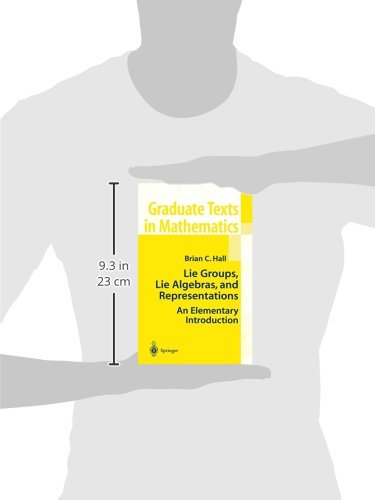



Full description not available
G**G
This is a great book
I love this book. I like to think I am a good mathematician, but I have always had a lot of trouble with differential geometry. I suspect there are a lot of people out there like me. This book presents Lie Groups using matrix groups, which makes things much more concrete. The book is not easy, and requires good linear algebra skills. However, many matrix algebra theorems are presented and proved in the appendices. The appendices also include the abstract definitions of Lie groups and algebras for general manifolds which are topological groups, with examples, and the author always explains how the theorems for matrix groups relate to those for general Lie groups, and in many cases little modification seems to be necessary.There are plenty of exercises at the end of each chapter that are of just the right difficulty to help you understand the material.I got the first edition, since the second edition seems to be available only in paperback and I prefer hardcover. There seem to be a lot of typos in the first edition that are easy to spot. I imagine they have been corrected in the second edition. I don't know what other changes were made.Some people who reviewed this book complained that it does not fully reveal the pristine beauty of general Lie groups. This may be true, but a book that I cannot read is not going to do me any good. Also, many people who use Lie Groups only really need matrix groups and this may be a good book for them.
C**M
Best book out there to learn Lie theory from
I used this text last year for a third year undergraduate course on Lie groups, Lie algebras and representations and it was excellent! I found the exposition to be super clear and easy to follow. Also, I really loved an entire chapter that focused on the representation theory of $\mathfrak{sl}_3(\Bbb{C})$! As I grow older, I discover more and more the importance of having a concrete grasp of examples - and Brian's book does it in exactly that way. Plus, it is not disorganized and does not handwave like Fulton and Harris (which has gaps in its proofs using Weight diagrams in the chapter on representations of $\mathfrak{sl}_3$) and is not dry and abstract like Humphreys' book!I would say that this is the best book out there to start learning Lie theory from.
V**N
Four Stars
good
R**R
AT LAST, LIE GROUPS & ALGEBRAS I CAN UNDERSTAND!!
This book focuses on matrix Lie groups and Lie algebras, and their relations and representations. This makes things a bit simpler, and not much is lost, because most of the interesting Lie groups & algebras are (isomorphic to)groups & algebras of matrices. I believe that most mathematicians are more concerned with impressing their colleagues with their subtlety and erudition than they are in making a clear, simple and comprehensible presentation. This is mitigated by the publisher's insistence that the first 10 pages be clear to a mid-level undergraduate so the book will sell. So I usually get stuck at page 10 in those books. This book is clear (to me) at least to page 168 (as far as I have progressed). There are even appendices on finite groups and key aspects of linear algebra. After introducing the classical groups and their algebras and the exponential map relating one to the other, the author introduces representations. He then details the representations of sl(2,C) and sl(3,C) (a.k.a. the complexifications of su(2) and su(3), respectively). By going through the details on these [with their Cartan subalgebras, weights, roots, Weyl groups, etc.], the general theory that follows is more palatable than it might otherwise be. Little rigor is sacrificed (if I am qualified to judge that - probably not). A few proofs are left out, but not many. Another virtue of this book is that there are very few mistakes. I have trouble distinguishing an author's typos from my thinkos, so this is a particularly impotant feature of this book. I very highly recoommend this book to anyone who does not already know the subject; it would be a perfect first book on this area. This book is really written with the student in mind. As a "shade - tree" mathematician, I need all the help I can get in understanding this difficult subject. Hall has done the best job I have seen at making the theory accessible without sacrificing rigor.
J**M
Companion book suggestion
This is an excellent book on a difficult subject.When learning Group Theory from the viewpoint of physics, one can miss out completely on some of the important mathematical aspects.Halls book solved that problem for me. But, I can imagine that it also works in the reverse;If one studies Group Theory from a pure mathematical viewpoint, one can miss out on a multitude of computational techniques and some important results.The paramount example of Halls book is the handling of the representations of the group SU(3).To gain even more insight into that group one can use Halls book together with Quantum Mechanics: Symmetries .There one can see "Groups, Algebras and their Representaions in Action", especially SU(3),in numerous solved excercises and problems displaying a multitude of relevant computational techniques.The two books begin at about the same point (groups, algebras, representations, the exponential map),and end at about the same point (classification of the classical groups).Halls book provides the correct mathematical setting and Greiners book the solved examples.The two books together add up to a lot of value.The pure math student can easily ignore the physics in Greiners book and pick up some new things in representation theory,such as Cartans criterion for irreducibility, derivations of dimension formulas for representations, etc.Meanwhile, the pure physics student should probably avoid trying to learn Group Theory from physics books (including Greiners).There is a lot of confusion in the physics books as to what is what. Groups, algebras, representations and invariant subspaces are constantly mixed up.In conclusion, one benifits from a math book, and a large collection of examples. Halls book and Greiners book work surprisingly well together.
H**W
リー群の大まかなことを知るには良いと思います。
マトリックス・リー群(例えばGL(n, C)など)の既約性などの構造をBaker-Campbell-Hausdorff 公式を基に指数写像とリー代数との関係を用いて説明した入門書である。このような説明方法は正統的なものでなく、一般のリー群に適用できる物でないと著者自身告白している。あえてこの方法を採った理由としてリー群を今まで以上により具体的に読者に実感して欲しいからである。この本の第2部での表現論では群の次元は2または3である半単純群を題材にしている。この本の副題に"Elementary Introduction"とあるので、リー群をより実感して欲しいという著者のねらいは妥当だと思う。また、本書の大きな特徴として、かなり多くのページ数を割いた付録をあげることが出来る。正統的な方法によるリー群の説明の要約、線形代数の要約、多様体、クレプッシュ・ゴルダン理論、基本群などを説明してある。リー群の構造をリー代数の構造に帰着する考え方はこの本でも基本なので、この本を読んだあとでどうしてもリー代数に付いて知りたくなるのは必然だと思う。リー群の一般論を学んだ後にリー群をより実感できより具体的に知りたい人に適した本であると思う。
Trustpilot
2 days ago
3 days ago